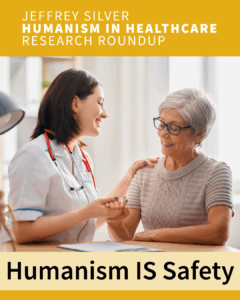 The Jeffrey Silver Humanism in Healthcare Research Roundup features summaries of recently published studies on humanism in healthcare. To receive email notification of new studies once per month, enter your information here and select “Jeffrey Silver Research Roundup” from the checkboxes at the bottom. See previous posts in this series.
The Jeffrey Silver Humanism in Healthcare Research Roundup features summaries of recently published studies on humanism in healthcare. To receive email notification of new studies once per month, enter your information here and select “Jeffrey Silver Research Roundup” from the checkboxes at the bottom. See previous posts in this series.
Publications from Gold Foundation-Affiliated Authors
Exploring the surgical gaze through literature and art
Kirkland KB, Craig SR. JAMA. 2018 Apr 17;319(15):1532-1534.
This project was supported by a Picker-Gold Challenge Grant.
In this Picker-Gold funded project, the authors spent a year training surgery interns in how to use narrative medicine techniques to help them become compassionate surgeons. Learners were required to meet twice a month during which they examined poems, fiction, paintings or photographs and took part in group conversations and writing exercises. As the interns learned to notice what they did and did not see, and how their observations changed over time, they gained insight into themselves as humans and as healthcare professionals.
Considering axiological integrity: A methodological analysis of qualitative evidence syntheses, and its implications for health professions education
Kelly M, Ellaway RH, Reid H, Ganshorn H, Yardley S, Bennett D, Dornan T. Adv Health Sci Educ Theory Pract. 2018 May 14.
This study was supported by a Mapping the Landscape grant.
Qualitative evidence synthesis (QES) is a suite of methodologies that combine qualitative techniques with the synthesis of qualitative knowledge. These methods are particularly suited to health professions education, so authors of this study wanted to learn more about how these methods were being used in research about humanism in healthcare. They analyzed 49 reviews and found that the publications rarely paid attention to the value of the source materials. They concluded that QES should be used in research about health professions education, but that value of the source material should be further explored.
Impact of medical scribes on physician and patient satisfaction in primary care
Pozdnyakova A, Laiteerapong N, Volerman A, Feld LD, Wan W, Burnet DL, Lee WW. J Gen Intern Med. 2018 Apr 26.
Dr. Lee is a Mapping the Landscape grantee.
Researchers wanted to see how the use of scribes affected physician and patient satisfaction at an internal medicine clinic. Over the course of three months, physicians had clinic sessions with and without a scribe. Younger patients reported that their physician was more attentive and provided more education during visits with a scribe compared to visits without a scribe. When working with a scribe, physicians were more satisfied with clinic workflow, and the length of their post-clinic documentation decreased from 1.65 hours to 0.76 hours.
Healthcare at the crossroads: The need to shape an organizational culture of humanistic teaching and practice
Rider EA, Gilligan MC, Osterberg LG, Litzelman DK, Plews-Ogan M, Weil AB, Dunne DW, Hafler JP, May NB, Derse AR, Frankel RM, Branch WT Jr. J Gen Intern Med. 2018 May 8.
Drs. Branch, Rider, Plews-Ogan, and Frankel have been involved with the Gold Foundation Research Institute.
Across eight U.S. medical schools, many faculty members took part in a one-year faculty development program to enhance humanistic practice and teaching. Sixty-eight of these faculty members wrote reflections about what kinds of organizational factors promote or inhibit the humanistic practice of medicine. Motivators included leadership supportive of humanistic practice, a responsibility to role-model humanism, organized activities that promote humanism, and practice structures that facilitate humanism. Barriers included top-down organizational culture, as well as time and bureaucratic pressures.
Teaching medical educators how to teach communication skills: More than a decade of experience
Spagnoletti CL, Merriam S, Milberg L, Cohen WI, Arnold RM. South Med J. 2018 May;111(5):246-253.
Dr. Arnold is a Mapping the Landscape grantee.
Authors developed and evaluated a faculty development course about how to teach communication skills to trainees. Sixty-two clinicians who completed the course between 2003 and 2012 responded to a survey. 98% indicated that the course was effective in giving them skills to teach patient-doctor communication in both classroom and clinical settings. Working with standardized patients, teaching in small groups, and role-play were some of the strategies they used as a result of participating in the course.
Disclosure coaching: An ask-tell-ask model to support clinicians in disclosure conversations
Shapiro J, Robins L, Galowitz P, Gallagher TH, Bell S. J Patient Saf. 2018 May 16.
Dr. Bell is a Gold Professor.
Authors developed an “Ask-Tell-Ask” model and materials to guide coaches and others who help clinicians disclose medical error. In this paper they describe a comprehensive approach that incorporates the model, its rationale, step-by-step coaching strategies and guidance (including sample scripts), and organizational considerations regarding implementation of a coaching program to support patient-centered transparent communication after harmful events.
Tackling ambulatory safety risks through patient engagement: What 10,000 patients and families say about safety-related knowledge, behaviors, and attitudes after reading visit notes
Bell SK, Folcarelli P, Fossa A, Gerard M, Harper M, et al. J Patient Saf. 2018 Apr 27.
Dr. Bell is a Gold Professor.
Researchers surveyed patients and family members who logged on to their patient portal and had at least one note available from an outpatient visit in the past 12 months. Of the 10,000+ respondents, the majority reported that reading the notes about their visit helped them understand and follow through on tests and referrals.
Other Publications
The suffering medical students attribute to their undergraduate medical education
Egnew TR, Lewis PR, Meyers KR, Phillips WR. Fam Med. 2018 Apr;50(4):296-299.
In focus groups, 51 medical students were asked to discuss what they learned in medical school about human suffering. During discussion, students also shared their stories of the suffering they attributed to the experience of medical school and the culture of medical education. Sources of suffering included isolation, stoicism, confusion about personal/professional identity and their role as medical students, and witnessing suffering in patients, families, and colleagues. Students described emotional distress, dehumanization, powerlessness, and disillusionment as negative consequences of their suffering. Reported means of adaptation to their suffering included distraction, emotional suppression, compartmentalization, and reframing.
The colours and contours of compassion: A systematic review of the perspectives of compassion among ethnically diverse patients and healthcare providers Free full text
Singh P, King-Shier K, Sinclair S. PLoS One. 2018 May 17;13(5):e0197261.
Authors conducted a systematic search of peer-reviewed research about compassionate care in ethnically diverse populations and synthesized 23 articles on the topic. Compassion was described as being composed of healthcare provider virtues (honesty, kindness, helpfulness, non-judgment) and actions (smile, touch, care, support, flexibility) aimed at relieving the suffering of patients. The importance and impact of providing compassion to ethnically diverse patients was also identified, which included overcoming cultural differences, alleviating distress at end-of-life, promoting patient dignity, and improving patient care.
Toward a comprehensive, theoretical model of compassion fatigue: An integrative literature review
Coetzee SK, Laschinger HKS. Nurs Health Sci. 2018 Mar;20(1):4-15.
Authors conducted a systematic search of nine databases and other literature and found 11 publications about theoretical models of compassion fatigue. They analyzed the strengths and weaknesses of the models and summarized them, saying that it is not empathy that puts nurses at risk of developing compassion fatigue, but rather a lack of resources, inadequate positive feedback, and the nurse’s response to personal distress.
Situated teaching improves empathy learning of the students in a BSN program: A quasi-experimental study
Lee KC, Yu CC, Hsieh PL, Li CC, Chao YC. Nurse Educ Today. 2018 May;64:138-143.
Researchers wanted to evaluate whether using situated teaching methods such as role play, self-reflection, and acting affected the empathy of undergraduate nursing students. Results showed that of the 103 students who participated in the study, subjective empathy increased significantly in the group who learned through situated teaching.



